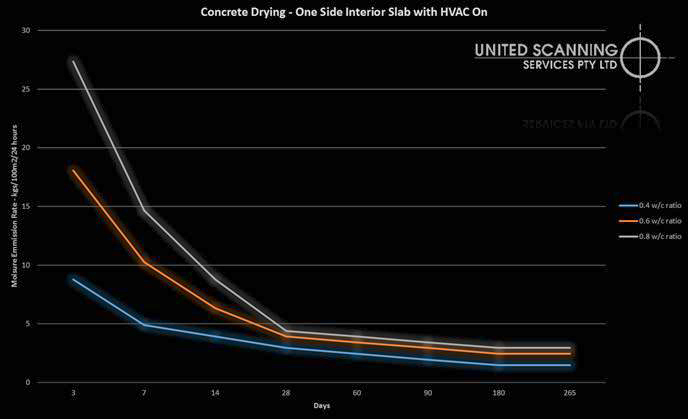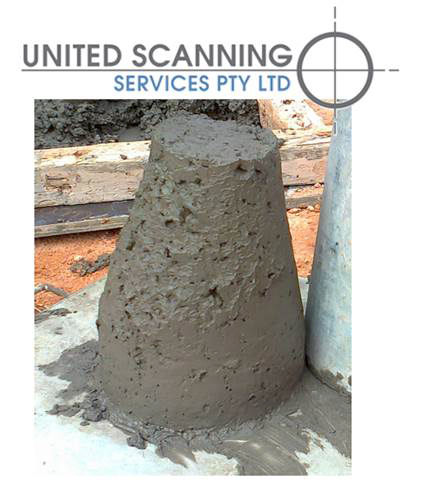Relative Humidity Testing
United Scanning provides its clients with advice throughout a broad variety of concrete projects. While United Scanning specialises in the use of Ground Penetrating Radar and Electro-Magnetic Detection and Tracing to identify services, reinforcement, defects and other features in concrete, our expertise is much broader than this alone. United Scanning is able to provide information and testing in a range of areas to assist our clients towards successful completion of their planned works.
One area of testing and analysis which United Scanning assists a number of clients with is Relative Humidity (RH) Testing, otherwise known as Concrete Moisture Measurement. The moisture content of concrete is of vital importance in construction projects at three specific points and the required relative humidity within the concrete at these points differs significantly.
The relatively humidity of the concrete while it is being mixed, delivered and poured is critical to the final appearance, durability and defect level of the concrete. Too much water in the concrete can lead to excessive shrinkage, cracking and a reduced compressive strength of the final product. Too little water and the concrete may not mix well, certainly will not flow well and the dryness of the concrete may result in areas of voiding and honeycombing. Typically, a slump test is used to verify the consistency of the concrete allowing our client to assess whether the batch being delivered is fit for purpose, with the adage “When in doubt, throw it out” being an essential piece of construction wisdom.

Figure 1: Cracking due to excess shrinkage
While the concrete cures, adequate water is essential and it is a fundamental requirement of the concrete chemistry that the concrete be adequately hydrated. Strong concrete requires moisture with each type of concrete having a specific level of moisture that is required during this stage. Not only must the concrete be adequately hydrated during curing, with the concrete sometimes requiring additional water during this stage (moist curing) but the concrete must also be protected from moisture loss until the curing is complete.
Finally, many floor adhesion products are very sensitive to humidity. Too much water will lead to a failure of the surface to adequately bond to the concrete, while concrete that continues to release water vapour after the surface is applied tend to exhibit bubbling of the surfacing. Drying of the concrete prior to flooring is very important to the longevity and appearance of the surfacing or flooring. Concrete that is drying under normal conditions can take anywhere up to 9 months to reach the appropriate level of relative humidity for the floor surface to strongly adhere or bond.
In summary, during mixing and pouring, the moisture ratio of the concrete needs to be just right, during the curing phase of concrete, relative humidity needs to be kept high, and finally, to allow for effective floor and surface adhering and bonding, the humidity must be relatively low, usually below 75%.

Figure 2 : Drying rate of concrete inside a building (indicative)
At each of these stages, accurate knowledge concerning the moisture content and relative humidity of the concrete can assist in the successful and timely completion of project objectives. Knowing early that the concrete being delivered is too dry or too wet can save millions in remediating defects. Monitoring the moisture levels during the curing process can allow for the introduction of additional moisture if it is discovered fluid has leaked or the temperature has resulted in more water than expected evaporating. This will ensure the concrete meets its requirements in terms of compressive strength. Finally, monitoring the relative humidity during the drying of the concrete can allow the application of floor surfaces as soon as the floor is appropriate dry but no earlier and so prevent failure of the surfacing.

Figure 3 : A slump tests success or failure rests partially on moisture content
The absorption, evaporation and migration of moisture through concrete can vary significantly depending on a wide variety of local conditions. The air humidity, the local temperature and air movement level or wind speed can significantly affect the moisture content of the concrete. Even the way the concrete has been worked can change the amount of moisture. A slab that has been power trowelled may have an increased drying time, while other treatments of the surface may speed up evaporation and drying.
RH testing is an essential part of successfully completing a concrete project. While it is possible to estimate the amount of moisture at each stage in the process, using calculations to assess water ratio in the concrete mix, required moisture for hydration during curing and maximum humidity for bonding of surfacing adhesives, these are still only estimates and no substitute for testing. Ambient conditions may cause the actual value to differ wildly from what is estimated at any stage and deliver results that are less than optimum.
Being able to provide clients with clear insights into the humidity of their concrete and do so in a timely and accurate way, is an incredibly useful tool for our client and is a service that United Scanning is an experienced provider of.
